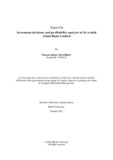Investment decisions and profitability analysis of Al-Arafah Islami Bank Limited

View/
Date
2022-10Publisher
Brac UniversityAuthor
Chowdhury, Nusrat JahanMetadata
Show full item recordAbstract
Islamic Banking sector is one of the fastest-growing sectors in Bangladesh. According to the
report of Bangladesh Bank, Islamic Banks hold 28.21% of the market share of the banking
market. Currently, 10 full-fledged Islamic Banking is operating in the country. Al-Arafah
Islami Bank Limited is the market challenger of the Islamic Banking industry. It was
incorporated on 27th September 1995 as a private Islamic Bank in Bangladesh. Currently, AIBL
has 201 branches across the country. It provides bank loans, security services, deposit schemes
etc. It is also involved in import-export businesses, industrial businesses, transportation, and
agriculture and it has other business investments. The popular deposit schemes of the bank are
the Mudaraba saving deposit, Pension deposit scheme, Bai Salam etc. To analyze the
profitability and investment of the bank, I have used both primary and secondary data. Primary
data are collected from the interview of the Bank’s supervisor and other primary data are of
my personal observation. Secondary data are collected from Annual reports, business
magazines, newspapers etc. In my study, I have found several issues at AIBL such as non performing loans, lack of effective human resources, network and service issues, centralized
management of the bank etc. The profitability and income from investment and non-investment
sectors are diminishing gradually in 2020 and 2021. There is a lack of quality human resources
at Dakshin Khan Branch, Dhaka. AIBL does not allow investing under Mudaraba and
Musharaka modes in all branches. Bai-Muajjal is the largest mode of investment for AIBL in
the year 2020-21. Due to COVID, there is a reduction in the total investment of the bank. The
recovery rate of disbursement has fluctuated every year in business performance. To recover
the situation, I have added effective recommendations for AIBL. I recommend AIBL invest
more in other modes of investment such as Mudaraba and Musharaka modes to recover
investment losses and engage effective manpower in every branch. The bank should recover
disbursement on a quarterly basis. They should also solve network issues, change infrastructure
and management policy and update their KYC form to improve the bank’s performance.
